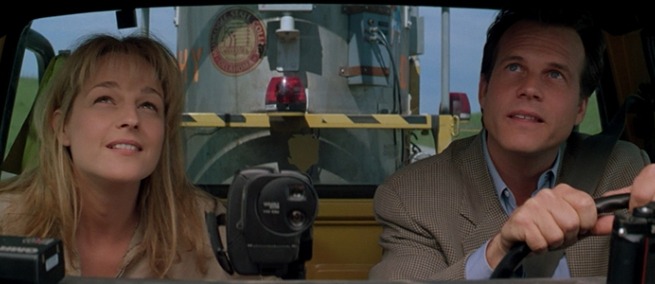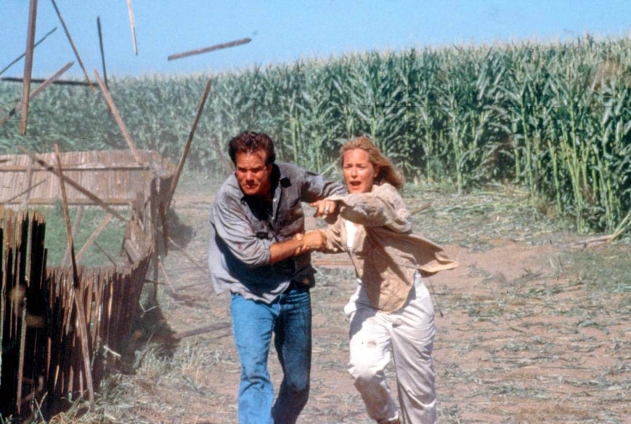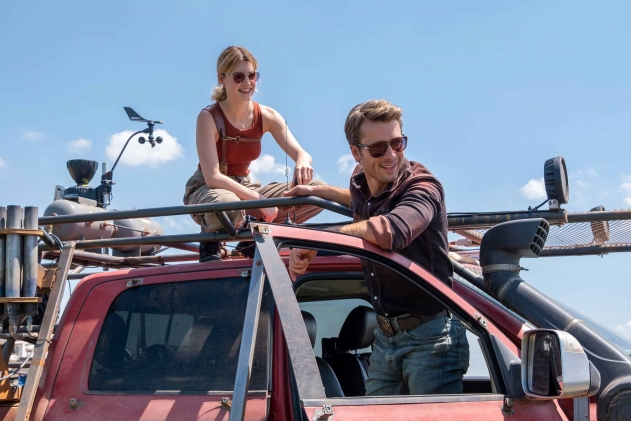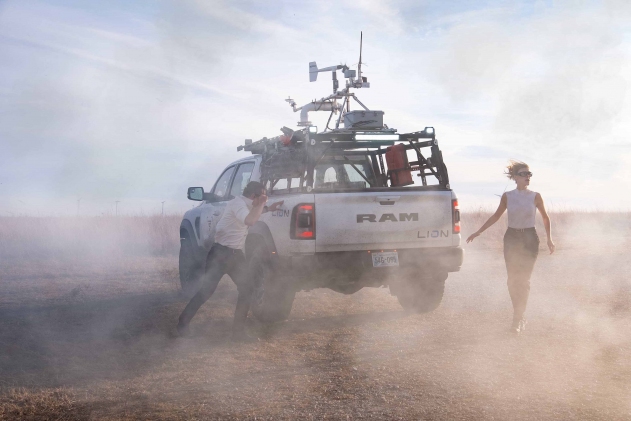
Almost two decades ago, the blockbuster TWISTER hit screens. With an all-star cast including Helen Hunt and Bill Paxton, the disaster film followed a group of storm chasers Oklahoma. The film’s sequel, ominously titled TWISTERS, is set to open in theaters this summer, on July 19. In anticipation of the new film, we spoke with Harold Brooks, who was the technical advisor on TWISTER. Brooks is a Senior Research Scientist at NOAA, the National Oceanic and Atmospheric Administration. We spoke about his work on the original film, thoughts on TWISTERS, and where the field of meteorology is headed.
Science & Film: Could you tell me a little about what you do at NOAA?
Harold Brooks: I'm a research meteorologist. My job titles officially Senior Research Scientist at the National Severe Storms Laboratory. I tend to spend most of my time thinking about the problems of climatology: the where, when, and and how strong severe weather events are, particularly tornadoes; forecast evaluation, so how do we actually evaluate the quality and value of weather forecasts?; and then issues involving climate and storms. That goes along with the climatology stuff, but it also tries to look at how have things changed? And how might they change?
S&F: How long have you been there?
HB: I came as a postdoc on August 1 of 1990 and became a federal employee on November 2 of 1992. I now realize I've been here for longer than half of the history of the lab.
S&F: So TWISTER came out in 1996 and we're now anticipating TWISTERS. What was your relationship to the original?
HB: In 1994 or 1995 the lab hosted a large field project, at the time the largest field project to look at tornadoes: Vortex. One of the challenges we had was that there was a lot of media interest. TV and print journalism wanted to travel along with vehicles or follow vehicles and do interviews and all that. 1994 was a pretty quiet year storm-wise, we didn't really get any good data that year, which happens with field projects. But also, the media interaction didn't go very well, because one of our top scientists was in the field a lot, they might not get back to late in the evening, and the media wanted to be doing stuff in the morning, and we were having him working 16 hour days sometimes. That wasn't very good. I was involved in some forecasting for the experiment and had been involved in helping design the experiment. For 1995, we knew we needed to do something different. My wife was expecting a child in May of 1995. So, I was going to be in Norman, so said I'll do the media stuff. In December of 94 the lab was contacted by some folks who were going to make a movie.
NOAA public affairs and NOAA headquarters is a group of people who at times live in fear of 'we're going to look bad.' So nobody from headquarters wanted any involvement. They basically said, field projects are going on and you've got a media point person for the field project, we're just going to treat this like it was media.

Still from TWISTER
We were visited by Jan de Bont, the director, who had just done SPEED. Joe Nemec who was production design also came. They did some looking around at the lab. They explained what they were going to do shooting wise, and schedule wise, and they sent at that point a copy of the script. I made some comments back to them about that. The movie didn't go through the normal rewrite process, because as I understand it they had gotten a hold of two people to do the late rewrite. I don't know who one of them was. The other one was Joss Whedon. One of the two guys was in a car wreck, the other guy got pneumonia, or mononucleosis or something. And so the two of them had to back out at the last minute. So Kathy Kennedy ended up doing a little bit of the rewrite, but it was a pretty light rewrite. They started showing up in April. They wanted safety training for cast and crew. They were going to be outside in the springtime in Oklahoma, and so we did a lot of stuff with lightning storms. It was all cast except Paxton, Hunt, Elwes, and Gertz. So everybody other than the four leads.
S&F: Who did you work most closely with?
HB: Probably my closest relationship ended up being with the art department coordinator, who was Carla Nemec. Carla came in and looked our operation center for the field project and basically said, this doesn't look good enough to be something we could show on camera, so we'll have to make it look a little prettier in the movie. And it looked a lot prettier. They apparently filmed another opening of the movie. And that was where this this great meeting of everybody takes place in classroom at OU after the Helen Hunt character has done a lecture. So I gave them stuff to put on a blackboard. I really wish I could get a copy of that snippet because there were some inside jokes for the meteorological community and Carla bought in on it.
So I did that kind of stuff with safety and the art department. Then, on April 17, our first day to get a good storm intercept, in the in the operation center we hosted Paxton. He was in for about three or four hours and he walked in about a minute before we got our first tornado for the field project. He was a very personable guy. He was great. The thing I still remember was that he walked in wearing this jacket that had an Apollo 13 logo on it. And I remember having this feeling--that would make a good movie--not realizing that that was his previous movie. We sent him out with our field teams. Then on the next day we operated, which was April 19. And a bunch of the other cast, the minor cast, that I ended up doing the safety stuff with some of them were met at the airport and went out on this. And that was a really difficult day to operate, because that was the Oklahoma City bombing day. So I was doing all kinds of communicating from the field because the FBI was asking us questions to collect information. Like, if you see this kind of a vehicle, please let us know. The guys who were in the vehicle with Paxton said he was in there listening to everything they said and then repeating a lot of it, he was tape recording and trying to get dialogue to ad lib on things.

Still from TWISTERS
S&F: When you say you operated, what does that mean?
HB: That means we were out collecting data for our field project. In some sense, we were doing what they were trying to do in the movie. We had field teams out with like 10 vehicles in the field and then I was in Norman to pass information along and to do what we call nowcasting, which is basically saying this is what the storms appear to be doing, or are about to do, so you can position yourself for whatever is happening. Our field coordinators deal with the teams in the field.
The last main cast member to arrive was going to be Helen Hunt. I got this message that Helen wants to talk to you. I remember she called the lab and we probably had a two hour long conversation. We went through most of the script. There was one part where she said, does that make any sense? And I go, No, no one would say that. And this was as they were deploying instruments. And asked what they would say. And from a documentary there's a very famous of a friend of mine making the comment deploy, deploy, deploy. And I said, that's what someone actually did say. And she said, I can't guarantee you it'll make it onto the final cut, but I guarantee you will be the first take. It ended up being something like prepare to deploy.
I tangentially knew the guys who were involved in doing the simulations. I was a graduate student at Illinois from 1985 to 1990. We did a visualization of storms with the National Center for Supercomputing Applications of the parent storms of tornadoes. We did a lot of stuff with them for for scientific purposes. Even though he wasn't part of the group that worked on our problem, Stefen Fangmeier was in the office next door, and he ended up basically doing the simulations that showed Spielberg that we could now do the simulations reasonably well. So the first tornado was Stefen's tornado. The rest of them are done by somebody else. And unfortunately, I almost interacted with him--he sent me this email, I'm looking to do simulations of tornadoes, so I need some information on wind speeds for a movie. He didn't tell me what movie. And I had been told to do whatever interaction with the Twister people [they needed] because that had been officially approved, but there were going to be a lot of other things that came out, like for television, at the same time, and [I was told] don't blow them off, but don't help them very much, because you don't need to be having all of your time working with movies. But watching the credits, I go, that's the guy who emailed me, and who never told me what project he was working on. We could have done a lot better with the videos, but that's life.
S&F: What is your feeling about the way the movie turned out, and how do you think it holds up?
HB: I'm a little biased. I recognize that the dialogues is not scientifically very good at times, but it's a movie. I wouldn't want to go to Hollywood for my scientific education. When I saw the script, the first thing I would have done is I would have made it more than one day long. I would have made it we have a failure, and we don't catch it. We don't even see storms. I said, you're out in the Texas panhandle and nothing happens at all, you can have a great romantic moment. We've got a seven-hour drive home, and we're really unhappy. That's real storm chasing--driving forever and not seeing anything. Apparently, Michael Crichton really wanted the time pressure.
One of the things that's actually in there, that's sort of the tribute to the supercomputer group, if you look at the end, when they show the things from Dorothy going up and coming down, things that go are orange, and things that come down are blue. That's a tribute back to Illinois. That was something Stefen got, because that looked like the video we had done with the special interest group.

Still from TWISTERS
S&F: Did you work at all on the new film, TWISTERS?
HB: I had one conversation. This conversation was with someone who was involved and did a little bit with TWISTER but is now retired from the lab. They were still looking for the hook. I'm really afraid they're going to try to blow up a tornado. Really afraid. That bothers because we're going to have people trying to blow up tornadoes.
S&F: Maybe it's too obvious, but why is that such a bad thing?
HB: On the science side, it's because we don't have any idea what it would do. It may actually make things stronger. We don't have any reason to think this is even a good idea to try. And I don't want any of my 100,000 closest friends running around, trying to bomb tornadoes and having things happen that may have less than desirable consequences in some places. So what I suggested, and I'm pretty sure this won't happen, could you imagine having some sort of incredible micro network of high resolution radars that you throw out in front of a storm, and you can then use that to run a really high resolution numerical forecast model that tells you where the tornado is going to be. That allows people the time to get safe and you end up saving lives. I don't like that. I could imagine this is something that could work, but I don't know how deploy 10,000 radars in a small area, but maybe 50 years from now. That would have been my preferred thing for them to do. There is a leap ahead in technology, as opposed to, let's just do something really weird, science-wise.
S&F: My related question just has to do with where the field is headed. Are the problems just getting bigger? Are they getting worse?
HB: At one level, yes, they're getting bigger, but they're also getting smaller. If we think back to 100 years ago, we were actually starting to get an understanding that tornadoes were associated with thunderstorms. People had crude theory about how they formed. If we go ahead to the 1950s, early 1960s, we start to understand, we actually start to know what part of the thunderstorm the worst tornadoes form in. Big big advance because now it's like, it's not just the whole thunderstorm, it's usually a small area within the thunderstorm that we care about. And in about that time and into the early 70s, we started to get some understanding of the environmental conditions in which storms formed, and the radar presentation of storms. And so, we started being able to do more and more. What we're now down to is we're asking more detailed questions about formation, decay, what we oftentimes refer to in the field as failure modes. If we can answer the question, why are there tornadoes? The next question is, why aren't there a lot more? We're asking a lot more detailed questions, we're having to look at finer and finer scales of information. So in some sense, the problems are getting smaller that we're looking at, which makes the observational world harder. When all you care about is the balloons that are launched every 400 kilometers apart, once every 12 hours, that provides the information that's a pretty broad picture. Now, when we care about what's happening 20 meters above the ground in this little, tiny area right before the tornado forms, that's a lot harder to collect data, and to look at. That's where we're headed is getting that kind of fine scale information, and then figuring out how do we deal with the fact that we know we don't observe everything perfectly? So how do we combine all those observations with some uncertainty to actually make forecasts of what will be happening in the near future? And then, what's really the hard problem, is given the fact that we can forecast with the weather will be, how do we provide information to people in a way that they can make good decisions for themselves and prepared for the event? How much do we need to do? A lot of the tornado dangers are associated with housing quality. How do we make information that's useful? I think that's our biggest challenge now.
♦
TOPICS